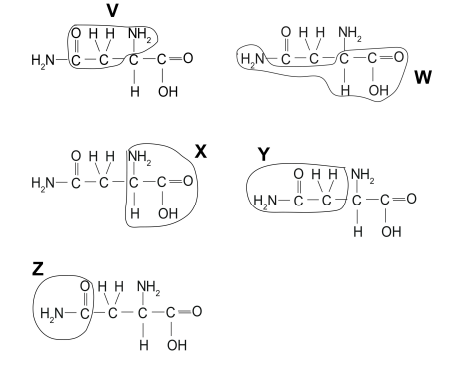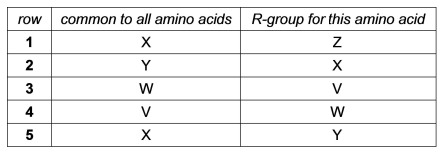The structure of the amino acid asparagine is shown. In each image (V-Z) a part of the structure is enclosed by a line.

Which line completely encloses the part of the molecule that is common to all naturally occurring amino acids and the R-group for this amino acid?

A. row 1
B. row 5
C. row 3
D. row 4
E. row 2
The answer to this question is B.
To be able to answer this question, we need to remind ourselves what amino acids are.
They are organic compounds that are composed of 2 distinct groups : one is invariant, and the other one, called the R-group, is specific to each amino acid. The invariant group, common to all amino acids, is made of 2 functional groups :
- Amino or -NH2
- Carboxyl or -COOH
They are both attached to an atom of carbon, that we will call Cα ; that same atom is linked to a single atom of hydrogen and the R-group.
If we take glycine as an example (the simplest amino acid with a single hydrogen atom as its side chain), its chemical formula would be : NH2‐CH2‐COOH.
With that being said, let’s now proceed in a step by step manner :
-
First, we need to be able to identify the common structure to all amino acids. Now that we know that it’s made of an amino and carboxyl functional groups, item X fits that definition perfectly. That now leaves 2 rows to choose between : 1 and 5.
-
To identify the R-group, having found the common structure is imperative : indeed, Cα is the interface between both of these structures. The 2 options left are either Z or Y.
- Z does not make sense because the circled elements are not linked to Cα : it would have been correct if the CH2 linked to the circled amide group was also circled.
- Y is the only option for the R-group that fits its definition.
With that being said, we can determine that row 5 is the correct one, making answer B correct.
4 Likes

